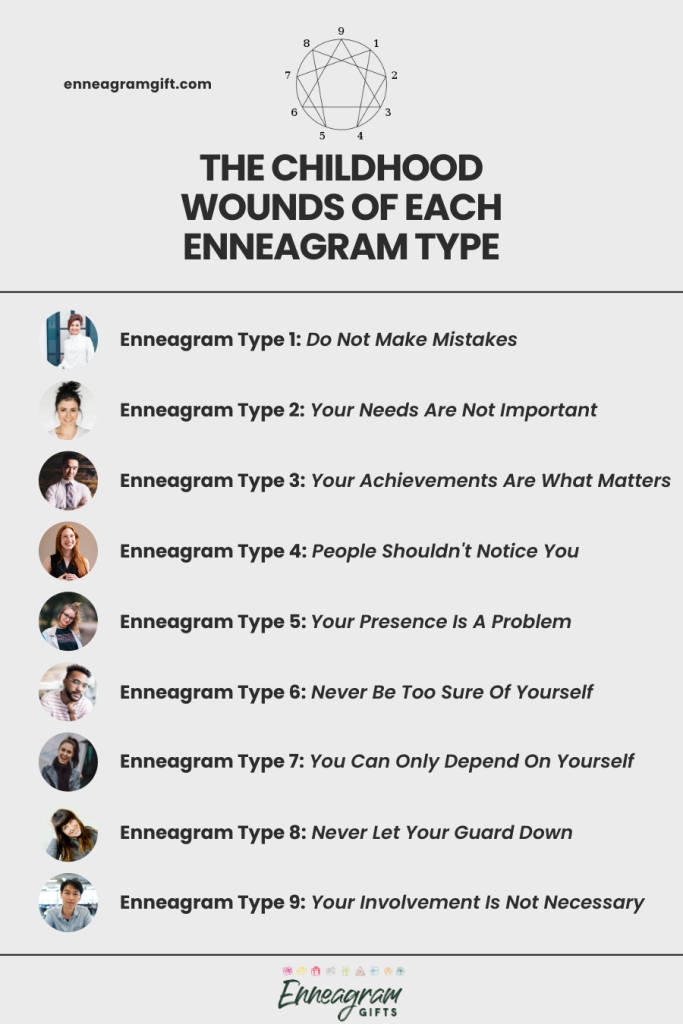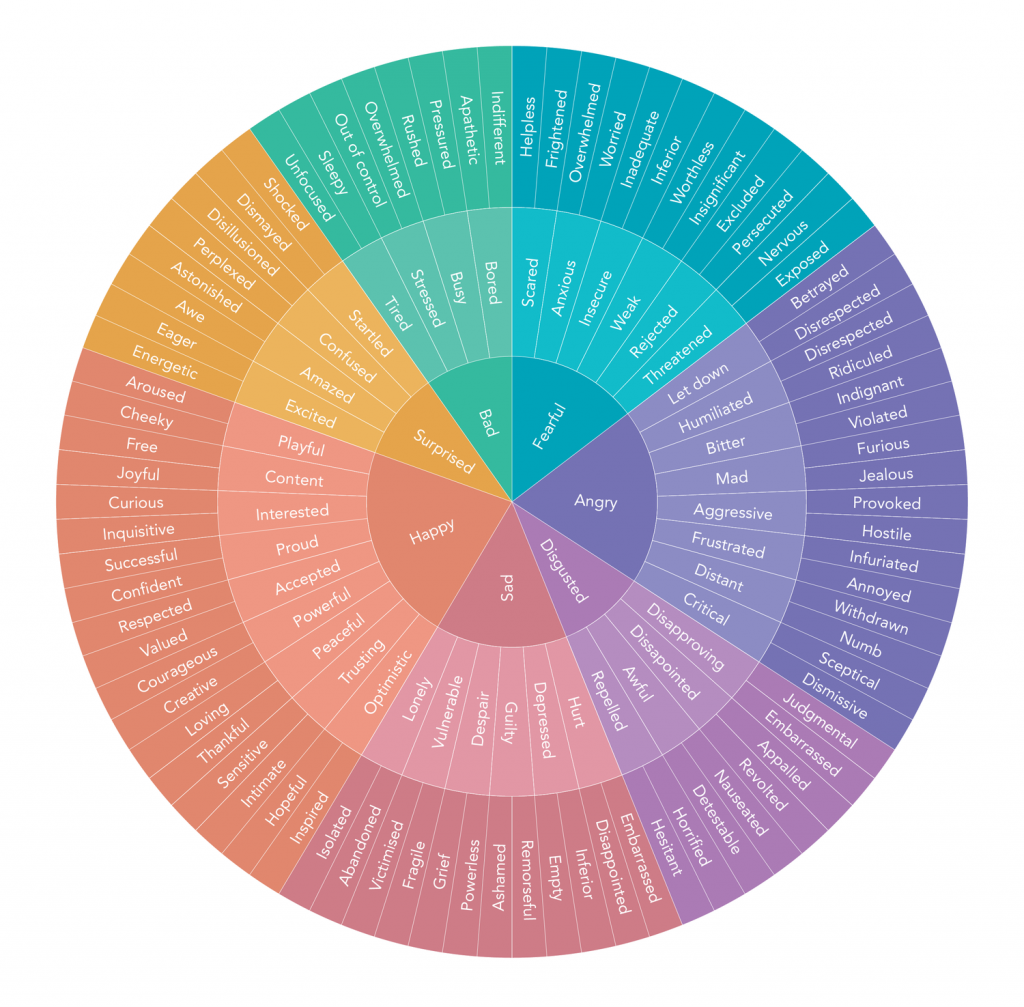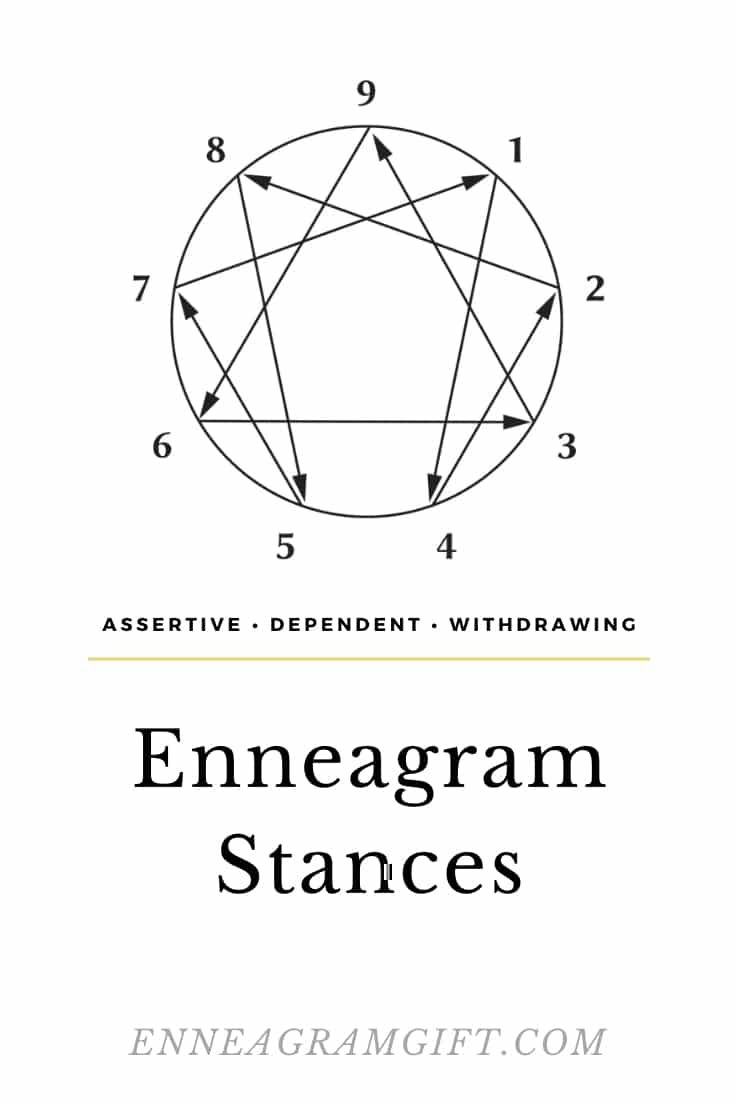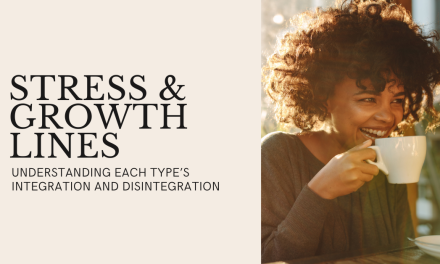The Enneagram is a powerful tool for understanding the nuances of human personality, helping individuals gain insights into themselves and those around them. Comprising nine distinct types, each with their own traits, the Enneagram sheds light on the significant childhood experiences that shape adult behaviors, known as Enneagram childhood wounds.
Every Enneagram type carries a specific childhood wound influencing their actions and responses. While children are inherently resilient and perceptive, they sometimes lack the necessary attention and empathy to fully flourish. Recognizing and understanding these childhood wounds is pivotal for personal growth and transformation.
In this article, we will explore the childhood wounds associated with each Enneagram type and provide guidance for healing and personal growth. Read on to delve into the world of Enneagram childhood wounds and discover pathways to healing and becoming a healthier version of yourself!

What Does The Enneagram Childhood Wound Mean?
The concept of the Enneagram childhood wound refers to a profound emotional hurt experienced during childhood. This wound significantly influences an individual’s personality and behavioral patterns as they mature. Often, children may find themselves in situations where their essential needs for empathy and understanding are unmet by parents or caregivers. In response, they devise adaptive strategies rooted in these painful experiences.
Each of the nine Enneagram types is characterized by a distinct childhood wound, resulting from traumas, whether minor or significant, experienced during their formative years. These wounds manifest as particular traits and self-limiting beliefs specific to each type.
The term “childhood wound” is commonly used to describe an integral aspect of Enneagram personality types and is likely to resonate deeply with individuals exploring this system.
8 Tips For Healing From Your Childhood Wound?
Embarking on the journey to heal your Enneagram childhood wound starts with embracing self-love and recognizing your inherent worth. Remember that healing is also fostered through the support and love from others. Surround yourself with friends and family who uplift and encourage you throughout this process.
Identifying a trusted confidant, coach, or counselor can be beneficial, providing a safe space to explore the impacts of past traumas. By discussing how your childhood wounds have shaped you, you can foster stronger relationships and cultivate a healthier self-perception.
It’s important to note that while these wounds often originate from parental figures, the hurtful message is not always delivered intentionally. Regardless, it is the message that is internalized and carries forward.
Navigating the path to healing involves exploring diverse practices that can aid in releasing trauma and cultivating a deep sense of freedom and well-being.
The effectiveness of these practices may vary based on your Enneagram type, but exploring a range of activities can be beneficial. Here are some suggestions, each with its own potential to aid in your healing journey:
- Rest: Prioritize rejuvenating sleep to allow your body and mind to recover and heal.
- Proper Diet: Nourishing your body with balanced meals can impact your mood and energy levels positively.
- Exercise: Engaging in physical activities can release endorphins, providing a natural mood boost.
- Meditation: Mindfulness practices can help in grounding your thoughts and fostering a sense of inner peace.
- Prayer: Spiritual pursuits can provide solace and a sense of purpose.
- Therapy: Professional guidance can help you navigate and process your childhood wounds.
- Reflection: Taking time to introspect can lead to self-awareness and understanding.
- Journaling: Expressing your thoughts and feelings on paper can be a therapeutic release.
Identifying the practices that resonate with your Enneagram type and integrating them into your routine is an empowering step towards self-care. Remember, the journey towards healing is deeply personal, and finding the practices that resonate with you is key to fostering lasting growth and well-being.

The Childhood Wounds Of Each Enneagram Type
Use The Links To Navigate To Each Type
- Enneagram 1
- Enneagram 2
- Enneagram 3
- Enneagram 4
- Enneagram 5
- Enneagram 6
- Enneagram 7
- Enneagram 8
- Enneagram 9
The Enneagram 1 Childhood Wounding Message: Do Not Make Mistakes
Enneagram Ones often grow up in environments characterized by criticism and judgment, where they internalize the message that making mistakes is unacceptable and perfection is the only standard.
Characteristics Shaped by the Wound:
In environments that may be overly strict, lenient, critical, or lacking in feedback, Type Ones often feel disconnected from protective figures. This isolation leads them to adopt a role as their own harshest critics. Haunted by thoughts such as “It is never good enough,” “Why does everyone else get to have fun?” and “I don’t deserve to be happy,” Type Ones strive incessantly for perfection.
Impact of the Childhood Wound:
This pursuit of perfectionism often comes at the expense of Type Ones’ own well-being, leading to potential health issues in the long run. Their demanding nature, aimed at both themselves and others, stems from a deep-seated desire to uphold high standards, driven by the fear of making mistakes.
How to Heal the Enneagram 1 Childhood Wound:
Healing for Enneagram Ones involves acknowledging and affirming their intrinsic goodness, independent of their accomplishments and efforts to improve their surroundings. Embracing compassion and grace towards themselves and others is crucial. Steps towards healing can include:
- Engaging in Reflective Practices: Journaling thoughts and experiences to gain insight and self-awareness.
- Finding Solace in Music: Listening to music that soothes the soul and offers a sense of calmness.
- Indulging in Leisurely Walks: Taking walks to connect with nature and find tranquility.
- Practicing Compassion: Cultivating a habit of being gentle and understanding towards oneself and others.
The Enneagram 2 Childhood Wounding Message: Your Needs Are Not Important
Enneagram Twos develop their childhood wound in environments that lack sufficient nurturing and guidance. This leads them to internalize the message that their worth is conditional, dependent on their ability to serve and care for others.
Characteristics Shaped by the Wound:
In an effort to feel needed and valued, Type Twos begin to prioritize others’ needs, often suppressing their own desires and emotions. This results in core beliefs such as:
- “Love and service are conditional.”
- “I am worthy because of what I do.”
- “I must earn my acceptance.”
Impact of the Childhood Wound:
Twos’ pursuit of love and validation manifests in consistently placing others’ needs ahead of their own, often to their own detriment. The drive to be indispensable can lead to feelings of guilt when considering their own needs, which they may view as selfish or self-serving.
How to Heal the Enneagram 2 Childhood Wound:
Healing for Enneagram Twos involves recognizing their inherent worthiness of love, independent of their acts of service. Twos must learn to express and prioritize their own needs, understanding that self-care is essential and not selfish. Steps towards healing can include:
- Engaging in Physical Activities: Participating in activities that allow them to reconnect with their bodies and needs.
- Dedicating Time for Self-Indulgence: Allocating moments for self-care and enjoyment.
- Practicing Self-Compassion: Learning to be kind to themselves and acknowledging their own needs.
- Expressing Needs Clearly: Cultivating the habit of openly stating their needs and desires in relationships.
The Enneagram 3 Childhood Wounding Message: Your Accomplishments Matter More Than You
The Enneagram Three childhood wound is deeply rooted in the belief that their worth is derived from achievements and external recognition. From an early age, Threes may feel compelled to prioritize accomplishments that bring praise, believing this is the path to admiration and love.
Characteristics Shaped by the Wound:
Enneagram Threes adapt skillfully to meet others’ expectations, often becoming chameleon-like in social situations. They may suppress traits perceived as negative, such as neediness and anger, and overemphasize characteristics like ambition and diligence. Striving to please, Threes can sometimes lose sight of their authentic selves, opting for a persona more readily accepted by their environment. This relentless pursuit often causes them to neglect their own opinions and emotions.
Impact of the Childhood Wound:
Threes may grow hypersensitive to criticism and rejection, working tirelessly to meet perceived expectations. Their childhood experiences lead them to believe that authentic expression could lead to isolation, and as a result, they often don a mask.
How to Heal the Enneagram 3 Childhood Wound:
Healing for an Enneagram Three involves embracing authenticity and vulnerability. Acknowledging and accepting all facets of their personality allows Threes to form more meaningful connections. By learning to separate their intrinsic value from external achievements, Threes can find a balance between their drive for success and their need for genuine relationships. Steps towards healing can include:
- Embracing Vulnerability: Creating a list of reasons why vulnerability is a strength and can lead to deeper connections.
- Seeking Honest Conversations: Engaging in open and sincere dialogues with trusted individuals to explore and express feelings.
- Understanding Emotions: Using resources like an emotion wheel to better identify, articulate, and understand their emotions.
- Reconnecting with Authenticity: Deliberately practicing authenticity to foster inner peace and genuine relationships.

The Enneagram 4 Childhood Wounding Message: People Shouldn’t Notice You
The childhood wound for Enneagram Fours stems from perceiving that displaying too much or too little emotion, or having intense interests, is discouraged or overlooked. This leads Fours to feel unseen and fundamentally different from those around them.
Characteristics Shaped by the Wound:
In response to this sense of otherness, Fours often engage in a lifelong quest for identity and belonging. They harbor a deep longing to be understood and accepted for their authentic selves. Some common feelings and experiences for Fours include:
- Loneliness
- Melancholy
- A sense of being perpetually “on the outside looking in”
- An emotional landscape marked by intense highs and lows
Impact of the Childhood Wound:
This childhood wound can result in Fours romanticizing relationships and longing for someone who can fully understand and embrace them. The persistent sense of not belonging can sometimes hinder the formation of deep, lasting relationships as they may subconsciously fear that no one can truly appreciate their uniqueness.
How to Heal the Enneagram 4 Childhood Wound:
Healing for Enneagram Fours involves embracing their inherent worth and accepting that they can be appreciated in their entirety, quirks and all. Steps towards healing can include:
- Practicing Gratitude: Focusing on the positive aspects of life and acknowledging the good that exists within and around them.
- Internalizing Positive Feedback: Learning to accept and cherish compliments and affirmations without undermining them.
- Challenging Internal Narratives: Gently questioning and reframing thoughts that underscore deficiency or alienation.
- Finding Beauty in the Ordinary: Recognizing and appreciating everyday moments, leading to a sense of contentment.
The Enneagram 5 Childhood Wounding Message: Your Presence Is A Problem
Enneagram Fives often grow up with the impression that their needs and presence are burdensome to others. This perception can develop from experiences of abandonment or feeling overlooked in childhood.
Characteristics Shaped by the Wound:
In response to this wounding message, Fives may strive to be as self-sufficient and unintrusive as possible. They may cope by amassing knowledge and immersing themselves in specific interests, believing that self-reliance will prevent them from being a burden. Traits shaped by this wound can include:
- A tendency to appear aloof or distant
- Avoidance of intimacy and vulnerability
- A strong desire for solitude to recharge
- Immersing oneself deeply in niche interests
Impact of the Childhood Wound:
The childhood wound may lead Fives to build walls around themselves, creating relational barriers. This withdrawal can sometimes result in feelings of isolation and perpetuate the belief that one must be self-reliant to survive.
How to Heal the Enneagram 5 Childhood Wound:
Healing for Enneagram Fives involves recognizing that their needs and presence are not burdensome, and that interdependence can be a source of strength. Fives can benefit from:
- Engaging in physical activities to foster mind-body connection
- Reaching out for meaningful conversations with trusted friends
- Practicing the expression of emotions and needs, even in uncertainty
- Cultivating curiosity and empathy towards others’ experiences and perspectives
The Enneagram 6 Childhood Wounding Message: Never Be Too Sure Of Yourself
Enneagram Sixes experience a childhood wound rooted in either 1) an overreliance on the opinions and strict guidance of authority figures, or 2) inconsistent, unpredictable, or absent feedback. These extremes lead Sixes to doubt their intuition and seek constant external validation.
Characteristics Shaped by the Wound:
Enneagram Sixes, often referred to as The Loyalists, may respond to this uncertainty by habitually overthinking and preparing for worst-case scenarios. They seek safety and assurance through relentless support and guidance from others before making decisions. Traits influenced by this wound can include:
- A tendency to operate by the principle “better safe than sorry”
- Suspicion and distrust of others
- Proneness to anxiety
Impact of the Childhood Wound:
The childhood wound of Sixes can lead them to struggle with self-doubt and an overdependence on external validation. The yearning for security often results in a cautious approach to life, hindering the acknowledgment of their capabilities and instincts.
How to Heal the Enneagram 6 Childhood Wound:
Healing for Enneagram Sixes involves learning to trust their intuition and understanding that security is attainable without excessive external validation. Steps towards healing can include:
- Trusting in one’s reasoning based on logic and available evidence
- Embracing mindful practices to manage stress and anxiety
- Building healthy and honest relationships that foster accountability
- Gradually shifting mindset from perpetual preparation for disaster to acknowledging their resilience and capabilities to navigate challenges
The Enneagram 7 Childhood Wounding Message: You Can Only Depend On Yourself
Enneagram Sevens experience a childhood wound rooted in a perceived absence of nurture and support. Consequently, they adopt a belief that they can only depend on themselves to fulfill their needs, leading to a constant pursuit of happiness and avoidance of discomfort.
Characteristics Shaped by the Wound:
Growing up in an environment where support from others felt scarce, Enneagram Sevens develop certain coping mechanisms and traits such as:
- Escapism: Avoiding uncomfortable situations by seeking pleasurable distractions
- Distrust: Being wary of relying on others
- Scattered thinking: Constantly planning and dreaming about future possibilities
- Resentment: Holding animosity towards those who challenge their ideas
Impact of the Childhood Wound:
The childhood wound can lead Sevens to prioritize future planning over addressing current situations and feelings. Their struggle to establish deep connections may stem from an ingrained message cautioning against dependence on others. This can result in relationships that remain at a surface level as Sevens instinctively sidestep emotional complexities.
How to Heal the Enneagram 7 Childhood Wound:
Healing for Enneagram Sevens involves learning to trust and lean on others, while also acknowledging and addressing their own vulnerabilities. Steps towards healing can include:
- Mindfully accepting love, care, and attention from others
- Embracing the idea that trusting others can be rewarding
- Seeking support when needed and acknowledging feelings of hurt
- Fostering meaningful relationships that affirm the trustworthiness of others and that contentment in the present moment is attainable

The Enneagram 8 Childhood Wounding Message: Never Let Your Guard Down
Enneagram Eights bear a childhood wound originating from insecure relationships with parental figures, particularly the mother. This instability propels Eights to adopt the role of the protector, compensating for the absence of guidance and positive leadership.
Characteristics Shaped by the Wound:
Growing up amidst uncertainty, Enneagram Eights cultivate certain characteristics to shield themselves:
- Anger: Using anger as a tool for protection and control.
- Avoidance of Affection: Staying guarded to prevent vulnerability.
- Isolation: Retreating from others to maintain a sense of autonomy.
- Control: Attempting to dictate the outcomes and decisions of others to ensure safety.
Impact of the Childhood Wound:
The wound influences Eights to perceive the world as a hostile place, requiring constant vigilance and strength. Their desire for protection manifests as combative behaviors, often interpreted by others as anger, defensiveness, or controlling tendencies. Eights often immerse themselves in work and other people’s problems to maintain control, inadvertently avoiding vulnerability and true connection.
How to Heal the Enneagram 8 Childhood Wound:
Healing for Enneagram Eights involves cultivating compassion for themselves and embracing vulnerability. Steps towards healing can include:
- Practicing Vulnerability: Opening up to a trusted circle of friends and family.
- Seeking Help: Identifying areas where they can relinquish control and accept assistance.
- Acknowledging Fear: Recognizing their fear of appearing weak and challenging this notion.
- Compassionate Reflection: Surrendering the belief that they must handle everything alone and acknowledging that it is okay to seek support.
The Enneagram 9 Childhood Wounding Message: Your Involvement Is Not Necessary
For Enneagram Nines, their childhood wound arises from a sensation of neglect and feeling overlooked by significant figures in their life. Though Nines often feel profoundly bonded with their guardians during their early years, they gradually come to believe that the path to peace is through suppressing their assertiveness.
Characteristics Shaped by the Wound:
Growing up feeling that their presence is unnecessary, Enneagram Nines develop specific traits as coping mechanisms:
- Procrastination: Delaying tasks and decisions to avoid conflict.
- Withdrawal: Sleeping excessively or frequently changing interests to escape from disappointments.
- Indecisiveness: Struggling to make decisions due to fear of disruption.
- Low Expectations: Minimizing expectations to guard against letdowns.
Impact of the Childhood Wound:
The wound leads Nines to downplay their needs and emotions, adopting an easy-going demeanor that masks their belief of insignificance. By lowering expectations, they protect themselves from disappointment, but this often results in a lack of assertiveness and engagement with life.
How to Heal the Enneagram 9 Childhood Wound:
Healing for Enneagram Nines involves recognizing their worth and understanding that their involvement is meaningful. Steps towards healing can include:
- Expressing Opinions: Practicing voicing thoughts and feelings with trusted individuals.
- Valuing Self-Worth: Cultivating new mindsets that affirm their value.
- Accountability: Seeking mentorship or friendship that encourages responsibility and goal-setting.
- Purposeful Living: Establishing goals and creating structures to realize their aspirations.
In Summary: The Enneagram Childhood Wound Is Significant Yet Can Be Overcome
The enneagram childhood wound you relate to the most will depend on your type. Every person experiences a wounding message as a child. The fact is, we live in an imperfect world, with people who make mistakes.
The enneagram childhood wound resonates differently for each type, underscoring the unique challenges faced during formative years. These wounds are a reflection of the inevitable imperfections in our upbringing and surroundings.
Thankfully, there is hope for every person to experience healing from their childhood wounds. The journey towards healing is paved with intentionality, humility, and constructive relationships. By acknowledging and addressing these wounds, individuals can embark on a transformative path towards self-improvement, fostering resilience and growth. Thus, the Enneagram serves not just as a mirror to our past but also as a compass guiding us towards a healthier and more authentic self.
If you need further help identifying your Enneagram type, check out the post: How to Find Your Enneagram With 4 Helpful Tips.
If you would like to find resources to explore your type in greater detail, check out some of our favorite resources HERE.





